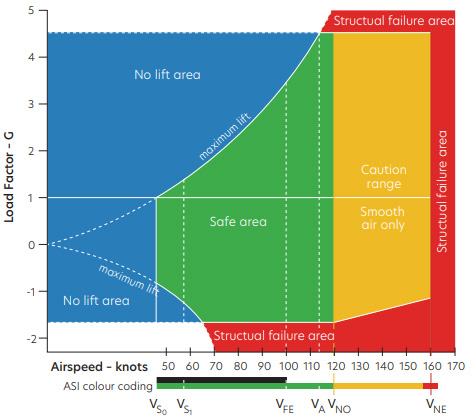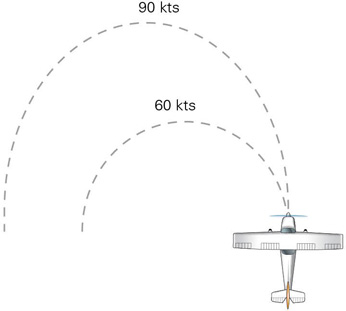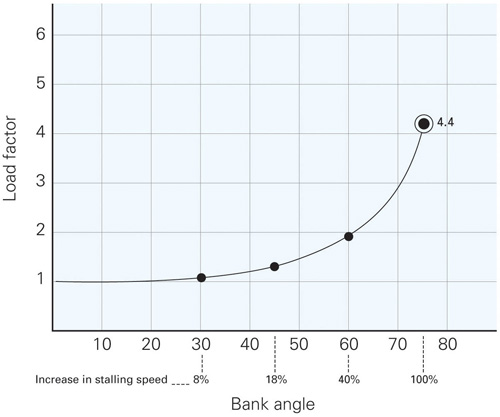Advanced manoeuvres
To achieve the maximum rate of turn, the greatest possible force toward the centre of the turn is required. This is achieved by inclining the lift vector as far as possible. Therefore, maximum CL (coefficient of lift), achieved at the maximum angle of attack, is combined with the maximum angle of bank.
The maximum rate of turn occurs when the aeroplane is changing direction at the highest possible rate, ie, maximum degrees turned through in minimum time. In most light two-seat training aeroplanes, the angle of bank during this exercise is approximately 60 degrees.
A minimum radius turn achieves a change of direction using less space and is usually done at a lower speed.
This briefing discusses the factors that limit the rate of turn, not only for the aeroplane being flown, but also for fixed-wing aeroplanes in general, so that the principles may be applied to subsequent types.
For the purposes of collision avoidance in response to an emergency situation, the turn entry requires a rapid roll in. The roll out is smoothly executed because the emergency is over. It should be noted, however, that the need to do a maximum rate turn suggests earlier poor decision making.
As an exercise, the rapid-roll in and smooth roll out provide excellent coordination practice, because two different rates of rudder and elevator application are required to match the rate of roll. Logically, these turns would not be continued past 180 degrees in the case of collision avoidance.
To carry out a balanced, maximum rate, level turn using full power.
The limitations of turning while using the highest possible angle of attack and at the highest possible angle of bank are discussed.
Briefly revise the forces in the turn and the increasing load factor with increasing angle of bank.
Lift varies with angle of attack and airspeed. The highest useful angle of attack is just before the critical angle, about 15 degrees. At this high angle of attack, maximum CL, considerable drag is produced, and if the aeroplane stalls, or the buffet is reached, the drag will increase dramatically. Ideally, sufficient backpressure should be applied to activate the stall warning (if it is operating) on its first note. Alternatively, the very edge of the buffet will need to be used as a guide to maximum CL.
Note: flying the aeroplane with the stall warning activated and not carrying out the stall recovery could be considered negative transfer. On the other hand, considerable situational awareness is required to purposely operate the aeroplane in this regime.

Figure 1 Vg diagram – velocity versus G loads or load factor
The speed we are particularly interested in, with regard to maximum rate turns, is VA (see Figure 1).
VA is the maximum speed at which the pilot can make abrupt and extreme control movements and not overstress the aeroplane's structures. Above VA and the aeroplane can be overstressed before it stalls. Below VA the aeroplane will stall before it is overstressed.
This is a particularly important consideration if the nose is allowed to drop during steep turns, and the pilot pulls back harder on the control column to regain height. The correct recovery technique is to reduce the angle of bank before increasing the back pressure.
VA is determined by multiplying the basic stall speed by the square root of the maximum load factor. If the aeroplane has a basic stall speed of 50 knots and a maximum flight load factor of 4, the VA speed would be 100 knots (50 × √4 = 100). Practically, the speed will be found in the Flight Manual.
VA is affected by the aeroplane's weight and reduces as weight reduces. This is because a heavier aeroplane will take longer to respond to a full control deflection than a lighter aeroplane. The quick response of the lighter aeroplane results in higher loading. Therefore, as the weight of the aeroplane is reduced, the speed at which full and abrupt control movements can be made is also reduced (refer Flight Manual).
Rate of turn is the rate of change of direction, ie, how many degrees are turned through in a specific time, usually a minute.
Radius of turn is the size of the arc made by the aeroplane as it turns.

Figure 2 High airspeed means high turn radius
A low speed means a higher rate of turn; a higher forward speed means a lower rate of turn.
A high speed allows you to generate more lift and therefore use an increased angle of bank, but the high airspeed means the radius of the turn (how many nautical miles it takes to make the turn) is high and therefore the rate will be lower (see Figure 2).
To turn at maximum rate we need maximum centripetal force and maximum lift. The increased angle of attack means increased drag, so full power is used. As rate of turn is proportional to velocity, the limiting factor in a maximum rate turn is power.
If speed is below VA at entry, full power can be used before rolling into the turn. If speed is at VA, full power can be applied in conjunction with the roll. When speed is above VA, roll into the turn first and then apply power, so as not to exceed VA.
To make a maximum rate turn, you need to turn at the highest angle of bank that can be sustained at the lowest possible airspeed – just above VS – that is why the stall warning is used to indicate maximum rate.
Somewhere between wings level and 90 degrees there is a practical limit to the angle of bank that can be used, as the aeroplane cannot be turned at 90 degrees angle of bank because there would be no vertical component to balance the weight, no matter how much lift was produced.

Figure 3 Increasing load factor, and stalling speed, with increasing angle of bank
This diagram shows the relationship of load factor to increasing angle of bank (see Figure 3). The structural load limit for the aeroplane will determine the maximum angle of bank that could be used without structural failure. Most light training aeroplanes have positive structural load limits of +3.8G in the normal category and +4.4G in the utility category. It can be seen that this limit is reached between 70 and 75 degrees angle of bank. Therefore, the average light training aeroplane cannot turn at angles of bank greater than about 75 degrees without causing structural damage.
From the graph, state the limiting angle of bank you will be using in your aeroplane.
The steep turn, generally approved as a semi-aerobatic manoeuvre in most light training aeroplane's Flight Manuals, involves an angle of bank of about 60 degrees.
Semi-aerobatic manoeuvres approved in the Flight Manual may be carried out only while operating in the utility category.
The difference between the normal and utility category is determined by the position of the C of G (refer Flight Manual). For most light training aeroplanes there is no difference in the C of G range, only a restriction that the baggage compartment must be empty for the aeroplane to be in the utility or semi-aerobatic category.
As was seen in the Steep turns lesson, an increase in angle of bank requires an increase in the angle of attack to increase the lift, which in turn increases drag, adversely affecting the L/D ratio, resulting in a decrease in airspeed.
Power is used to oppose the increase in drag. However, since power available is limited, the airspeed will reduce as the angle of bank increases.
The stalling speed increases as the square root of the load factor. With a basic stall speed of 50 knots, 75 degrees angle of bank increases the stall speed to approximately 100 knots. Even if there were no drag increase this would be about the normal cruise speed.
Therefore, the maximum angle of bank will also be limited by the amount of power available to overcome the increasing drag. For most light training aeroplanes, this is the limiting factor at about 60 degrees angle of bank. With the amount of power available, the highest possible speed that can be maintained is a stall speed well below VA (about a 40 percent increase over the basic stall speed). However, it's not necessarily the only limiting factor, as a light twin-engine aeroplane or high performance single may well have sufficient power to combat the increased drag and maintain or exceed VA. Commonly in this case, the aeroplane's structural limitations limit the maximum angle of bank.
The only other limitation on achieving the maximum rate of turn is that of the pilot.
If the airspeed is above VA for the weight, the entry must employ a smooth roll in. Generally, the application of power is delayed until the aeroplane decelerates to VA. Then, power is applied as required to counter the increasing drag in an effort to maintain VA (for the weight).
This would be any airspeed around the stall speed for 60 degrees angle of bank (VS plus about 40 percent, eg, 50 knots plus 40 percent = 70 knots).
In this case, power should lead the roll-in or be applied rapidly, but smoothly, as soon as the roll-in is started.
The aeroplane's VA speeds at all up weight and empty (if given in the Flight Manual) are most relevant to this exercise. A stall, or the use of abrupt control movements to initiate the entry, must be avoided above this speed.
Any organisation-imposed minimum altitude for the conduct of maximum rate turns should be stated (refer CFI).
For light training aeroplanes, the increase in drag will require that maximum power is used – do not exceed the RPM limit.
The aeroplane's C of G limitations for the normal and utility categories may be revised.
Disorientation is minimised by choosing a very prominent reference point. In addition, regular practice at conducting the turn through 360 and 180 degrees (in later lessons, refer CFI) will also improve orientation.
With an increasing positive load factor or G, the heart has more difficulty pumping blood to the brain. Because the eyes are very sensitive to blood flow, the effects on vision of increasing G are noted.
During the maximum rate turn, in most light training aeroplanes, the increased G would not be expected to exceed +2G.
Spots before the eyes form at about +3G, with grey-out occurring at about +4 to +5G, and blackout at about +6G.
These effects vary between individuals and are affected by physical fitness, regular exposure and anti-G manoeuvres or devices, for example, straining, or the use of a G-suit.
The air exercise discusses entering, maintaining and exiting the level maximum rate turn.
A reference altitude and very prominent reference point are chosen and the lookout completed.
A check is made to establish where the aeroplane's speed is, in relation to VA for the aeroplane's weight. For most light training aeroplanes the airspeed will be about 10 to 20 knots below VA when entering the maximum rate turn from level flight.
Assuming the airspeed is below VA, full power is applied and the aeroplane is rolled rapidly, but smoothly, into the turn with aileron, and balance maintained by applying rudder in the same direction as aileron. As large deflections of aileron are used, more rudder than usual will be required to overcome adverse yaw.
Backpressure is increased on the control column to keep the nose attitude level relative to the horizon, pulling smoothly to the stall warning (or light buffet) to maximise lift.
When the stall warning is activated, maintain backpressure and hold the angle of bank to maintain height. This will be recognised through attitude and confirmed through instruments, a slight check will be required to overcome inertia in roll and rudder pressure will need to be reduced to maintain balance.
In the entry from straight and level, excess airspeed may permit a higher angle of bank to be selected initially, especially if the roll is very rapid. However, as the airspeed reduces, the angle of bank will need to be reduced to CLmax to maintain altitude. Therefore, for the purposes of coordination, it may be beneficial to roll rapidly but smoothly, so that the airspeed reduction coincides with CLmax and with the application of full power (refer CFI).
If the very rapid roll-in is preferred (for a true avoidance turn rather than a coordination exercise), the initial angle of bank must not exceed the angle of bank at which the structural limits are reached.
Maintaining the turn incorporates the LAI scan. Emphasise lookout, and maintain the attitude for CLmax and level flight.
The effect of side-by-side seating on attitude recognition should be discussed, preferably with the aid of an attitude window.
During the turn, maintain the maximum amount of lift for the airspeed by maintaining the first note of the stall warning with backpressure.
As the lift cannot be increased any further, the altitude is maintained with angle of bank. Therefore, with the stall warning activated, if altitude is being gained or lost, alter the angle of bank.
Angle of bank can only be increased to the maximum coinciding with the aeroplane's structural limit. An alteration of ±5 degrees angle of bank should be sufficient to maintain altitude.
Look into the turn for traffic and the reference point, and allow for inertia by anticipating about 30 degrees before (half the angle of bank), and roll out smoothly.
Theoretically, the emergency is over; anticipating by half the bank angle will require a reduced rate of rudder application compared to the entry. This provides practice in coordination.
Smoothly roll wings level with aileron, balance with rudder in the same direction to overcome adverse yaw, and relax the backpressure to re-select the level attitude. Most low-powered training aeroplanes require the reduction of power to be delayed on exiting the maximum rate turn.
Therefore, through ____ knots (normally the same airspeed used in entering straight and level from the climb) reduce power to cruise RPM.
Once the student has taken you to the training area you should start the exercise with medium level turns, making sure the student notices the attitude. Follow with practice of the steep turns from the last lesson, also noting the attitudes required.
Then you take over and demonstrate, with patter, the maximum rate turn in one direction, followed by student practice with you talking them through, and then the student has the opportunity to practise. Then the other direction.
During one demonstration, the student's attention should be drawn to the rate of turn by looking at the rate at which the nose progresses around the horizon. If the aeroplane is brought to the buffet or stall, the rate of turn will noticeably decrease. Inclusion of this demonstration is at the CFI's discretion.
The majority of the lesson is taken up with student practice, as it may take some time for them to reach an acceptable standard.
Be clear with the student about whether you are happy for them to practise this exercise solo. There will be plenty of opportunity to practise these in dual flights.
Maximum rate turns whiteboard layout [PDF 98 KB]
Revised 2023